Lecture
Knowledge is the core of the learning content. Based on students' knowledge, skills and abilities, mental and practical actions are formed; knowledge is the basis of moral beliefs, aesthetic views, worldview.
But before we consider how students acquire knowledge, it is necessary to understand what knowledge is, what knowledge is, what knowledge a pupil should learn. This question is quite complicated.
The concept of "knowledge" is multivalued and has several definitions. It is defined as part of consciousness, then as something common in the reflection of objective diversity, then as a way of streamlining reality, then as a certain product and result of cognition, or as a way of reproducing a cognizable object in consciousness.
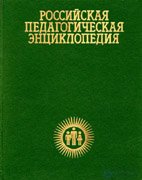 In the new "Russian pedagogical encyclopedia" (1993), "knowledge" is defined as follows: "a proven result of the process of knowledge of reality verified by sociohistorical practice and adequately reflected in human consciousness in the form of ideas, concepts, judgments, theories. Knowledge are fixed in the form of signs of natural and artificial languages "(Russian ..., 1993; abstract).
In the new "Russian pedagogical encyclopedia" (1993), "knowledge" is defined as follows: "a proven result of the process of knowledge of reality verified by sociohistorical practice and adequately reflected in human consciousness in the form of ideas, concepts, judgments, theories. Knowledge are fixed in the form of signs of natural and artificial languages "(Russian ..., 1993; abstract).
Elementary knowledge, due to biological laws, is also characteristic of animals, in which they serve as a prerequisite for their vital activity and the implementation of behavioral acts. Knowledge is an organic unity of sensual and rational. Skills and skills are developed on the basis of knowledge (see animation) (Tishchenko PD, 1991; abstract).
In all of these definitions, it says mostly about scientific knowledge. But besides scientific, there is everyday knowledge, personal knowledge, which are known only to one person. L.M. Friedman, analyzing the existing definitions of the concept of "knowledge", gives a definition of a more general nature: "Knowledge is the result of our cognitive activity, regardless of the form in which this activity was performed: sensually or out of touch, directly or indirectly; according to others, as a result reading the text, watching a movie or a television movie, etc. This result of knowledge is expressed by a person in speech, including artificial, gestural, mimic, and any other. Consequently, all knowledge is a product . Oznavatelnoy activity, expressed in symbolic form spoken opposite of ignorance, lack of knowledge, lack of ideas about what or whom ever "(Friedman LM, 1997, abstract).
The ambiguity in the definition of "knowledge" is due to the many functions that are realized by knowledge. So, for example, in didactics, knowledge can act as something that should be learned, i.e. as learning objectives, and as a result of the implementation of the didactic design, and as content, and as a means of pedagogical influence. As a means of pedagogical influence, knowledge comes about because, entering into the structure of the student’s individual past experience, it changes and transforms this structure and thereby raises the learner to a new level of mental development. Knowledge not only forms a new world view, but also changes attitudes towards it. Hence the educational value of all knowledge.
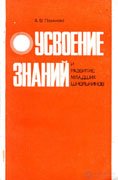 Knowledge and the right way to learn them is a prerequisite for the mental development of students. Knowledge itself does not yet ensure the fullness of mental development, but without them the latter is impossible. Being an integral part of a person’s worldview, knowledge largely determines his attitude to reality, moral views and beliefs, personality traits and are one of the sources of inclinations and interests of a person, a necessary condition for the development of his abilities (Polyakova AV, 1978; abstract) .
Knowledge and the right way to learn them is a prerequisite for the mental development of students. Knowledge itself does not yet ensure the fullness of mental development, but without them the latter is impossible. Being an integral part of a person’s worldview, knowledge largely determines his attitude to reality, moral views and beliefs, personality traits and are one of the sources of inclinations and interests of a person, a necessary condition for the development of his abilities (Polyakova AV, 1978; abstract) .
Everyday knowledge , based on common sense and everyday consciousness, is an important indicative basis for everyday human behavior. Ordinary knowledge is formed in everyday experience, on the basis of which mainly external aspects and relations with the surrounding reality are reflected. This form of knowledge develops and enriches as scientific knowledge progresses. At the same time, scientific knowledge itself incorporates the experience of everyday knowledge.
Scientific knowledge is a systematic, generalized level of knowledge, the formation of which is based not only on the experimental, empirical, but also on the theoretical forms of reflecting the world and the laws of its development. In its abstract forms, scientific knowledge is not all and not always available, so it involves such changes in the form of its presentation that ensure the adequacy of its perception, understanding and assimilation, i.e. academic knowledge. Thus, academic knowledge is derived from scientific knowledge and, in contrast to the latter, is the knowledge of what is already known or known (see Khrest. 7.1).
Scientific knowledge can be transferred through organized targeted training. They are characterized by the interpretation of facts in the system of concepts of this science.
The scientific knowledge obtained by the student in school often diverges and even contradicts the everyday ideas and concepts of the child due to the limited or one-sided experience on which the latter relies. Mastering scientific concepts that have a strictly defined value in a given scientific field (for example, the concept of a body in a physics course), students understand them in accordance with a narrower (or wider) everyday meaning.
Deliberate change, reorganization of scientific knowledge, simplification or reduction of subject diversity, which is reflected in scientific knowledge, taking into account the psychological capabilities of students, generates educational knowledge. The knowledge learned in the learning process should be systematized, interrelated, cover all the main things in the studied area, have a certain logical structure and be absorbed in a certain sequence. Along with intradisciplinary connections, usually related to the same academic subject, interdisciplinary connections should also be created.
An adapted form of scientific knowledge forms an academic discipline, which includes, on the one hand, the subject area of knowledge, and on the other - knowledge of the laws of cognitive activity. The language form of the expression of academic knowledge forms the educational text.
Any knowledge, including training, is subjective in the form of its existence, and therefore it cannot be mechanically transferred "from head to head", like a baton passed from hand to hand. Knowledge can be acquired only in the process of the subject's cognitive activity. It is by its subjectivity that scientific or academic knowledge differs from scientific or educational information, which is an objectified form of knowledge recorded in various texts.
Distinguish between the depth and breadth of knowledge, the degree of completeness of their coverage of objects and phenomena in a given area of reality, their characteristics, patterns, and the degree of granularity of knowledge. Organized school education requires a clear definition of the depth and breadth of knowledge, the establishment of their volume and specific content.
Awareness, meaningful knowledge, their saturation with specific content, the ability of students not only to name and describe, but also to explain the facts under study, to indicate their relationships and relationships, to substantiate digestible positions, to draw conclusions from them - all this distinguishes meaningful knowledge from formalized ones.
The school diagnoses mainly the fullness and strength of knowledge, the remaining parameters of knowledge in their effect on mental development are often out of the attention of the teacher. The student’s learning also includes the presence of separate disparate skills and abilities - both general educational methods (among them methods of searching for educational information, separate methods of memorizing, storing information, working with a book, etc.) and private ones (skills of counting, writing, etc.). Their diagnosis reveals gaps in the results of past training. Learning is revealed by tests of achievements, ordinary school examinations.
(http://testolog.narod.ru/Theory19.html; see the work of Avanesov VS "Theory and methods of pedagogical measurements").
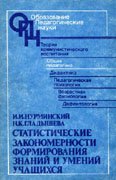 The basis of learning is the active mental activity of students, directed by the teacher (Nurminsky II, and others, 1991; abstract).
The basis of learning is the active mental activity of students, directed by the teacher (Nurminsky II, and others, 1991; abstract).
The process of educational knowledge consists of several stages. The first of these is the perception of an object, which is associated with the selection of this object from the background and the definition of its essential properties. The stage of perception replaces the stage of reflection, at which the discretion of the most significant external and intra-subject relations and relationships takes place. The next stage of knowledge formation involves the process of capturing and memorizing the selected properties and relationships as a result of their repeated perception and fixation. Then the process moves to the stage of active reproduction by the subject of perceived and understood essential properties and relationships. The process of mastering knowledge completes the stage of their transformation, which is associated either with the incorporation of the newly perceived knowledge into the structure of past experience, or with using it as a means of building or isolating another new knowledge.
Very often, the listed stages of knowledge formation are accepted as criteria for assessing the levels of their learning.
It is clear that if knowledge remains at the first stage, then their role for development is small, and if the student applies them in unfamiliar conditions and assesses, then this is a significant step towards mental development.
The establishment of levels of learning in diagnostics is important because these levels affect the quality of thinking, its stereotyped or non-stereotyped, originality.
Similar levels of learning are offered and V.P. Bespalko. Differentiating between reproductive and productive activities and examining their structure from the point of view of independence of execution, the scientist identified the following levels of learning information mastering (Bespalko V. P., 1989) (see Fig. 4):
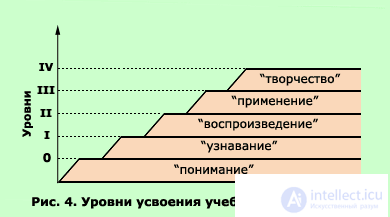
| Level of learning | Level name | Level characteristic |
|---|---|---|
| 0 (zero) | Understanding | Lack of trainee experience (knowledge) in a particular type of activity. At the same time, understanding demonstrates its ability to perceive new information, i.e. about the availability of learning |
| I | Recognition | The learner performs each operation of the activity, based on the description of the action, a hint, a hint (reproductive action) |
| II | Reproduction | The student independently reproduces and applies the information in the previously considered typical situations, while his activity is reproductive |
| III | Application | The ability of the learner to use acquired knowledge and skills in atypical situations; in this case, its action is regarded as productive |
| IV | Creation | The student, acting in the field of activity known to him, in unforeseen situations creates new rules, algorithms of actions, i.e. new information; such productive actions are considered to be real creativity |
The above criteria and levels of learning are widely used in teaching practice and for scientific purposes in assessing the quality of learning by schoolchildren.
Touching on the issue of mastering the knowledge recorded in scientific and educational texts, it is important to note one significant circumstance. The same scientific or educational text can be perceived and understood differently by different subjects. In this regard, in scientific and practical terms, the problem of understanding in general and the problem of ensuring the unambiguous understanding of the same oral or written scientific or educational texts by different people are of particular importance.
Until now, there is no single definition of "understanding". This explains the lack of generally accepted criteria for its diagnosis. All currently existing definitions of the concept are reduced to indicating one or more signs of external expression, the manifestation of understanding.
For example, if we relate knowledge and understanding between ourselves, the latter can be interpreted as a new vision of already known knowledge. Therefore, the transfer of knowledge to new conditions is regarded as a sign of understanding (Ginetsinsky, VI, 1992). But this point of view is not the only one. In a number of works, understanding is associated with the ability of the subject to perceive the various connections and relations of one object with others. Based on this definition, the leading sign of understanding is the variability of the ways of seeing the same object or the same properties in their various connections and relationships. As an illustration, we can give an example of a diverse representation in the form of a representation, for example, a theorem by means of verbal, graphic, symbolic, mathematical, mathematical methods of describing it. Among the supporters of this view can be attributed A.V. Smirnova, who sees as a leading understanding the translation of a school text or a scientific text into his language, i.e. the ability of the subject to express the content of the educational or scientific text in their own words (Smirnov AV, 1975). Yu.A. Samarin considers external expression of understanding the use of knowledge by students in other conditions (Samarin Yu.A., 1962). The same criterion is often taken as an indicator of the level of learning. A sign of understanding, according to L.N. Doblaev, is to ask students to read the text (Doblaev LN, 1972). A large group of scientists defines understanding as the process of reversible translation of abstract-logical forms of information into its figurative and visual forms. The understanding of the text can be judged by the adequacy of the behavior or actions that are provided for in this text. I.A. Winter associates the understanding of the text with the adequacy of the reconstruction, the reproduction by the recipient of the meaning of its content (Fig. 5) (see Ch. 7.2).
The immediate goals of any school subject are students' mastering the knowledge system and mastering certain skills and abilities. At the same time, the mastery of skills and abilities occurs on the basis of the mastering of effective knowledge, which determines the corresponding skills and abilities, i.e. indicate how to perform a particular skill or skill (see animation).
In order to understand the question of the ways and mechanisms of formation of skills and abilities in students, it is first necessary to understand what skills and abilities provide (see Khrest. 7.3).
До сих пор не уточнены соотношения между понятиями "умения" и "навыки". Большинство психологов и педагогов считают, что умение - более высокая психологическая категория, чем навыки. Педагоги-практики придерживаются обратной точки зрения: навыки представляют более высокую стадию овладения физическими упражнениями и трудовыми действиями, чем умения.
Одни авторы под умениями понимают возможность осуществлять на профессиональном уровне какую-либо деятельность, при этом умения формируются на базе нескольких навыков, характеризующих степень овладения действиями. Поэтому навыки предшествуют умению.
Другие авторы под умениями понимают возможность осуществлять какое-либо действие, операцию. По их понятию, умение предшествуют навыку, который рассматривается как более совершенная стадия овладения действиями.
Ability and skill is the ability to perform a particular action. They differ in the degree (level) of mastering this action.
A skill is the ability to act that has not reached the highest level of development, performed fully consciously .
Skill is the ability to act, has reached the highest level of formation, performed automatically, without awareness of intermediate steps .
When a person reads a book, controlling its semantic and stylistic content, the reading of letters and words occurs automatically. When he reads a manuscript to identify typos in it, the control is already directed at the perception of letters and words, and the semantic side of the written goes to the background. But in this and in another case, a person can read, and this skill is brought to the skill level (Ilyin EP, 1986, p. 138-147).
Умение - это промежуточный этап овладения новым способом действия, основанным на каком-либо правиле (знании) и соответствующим правильному использованию знания в процессе решения определенного класса задач, но еще не достигшего уровня навыка. Умение обычно соотносят с уровнем, выражающимся на начальном этапе в форме усвоенного знания (правила, теоремы, определения и т.п.), которое понято учащимися и может быть произвольно воспроизведено. В последующем процессе практического использования этого знания оно приобретает некоторые операциональные характеристики, выступая в форме правильно выполняемого действия, регулируемого этим правилом. В случае каких-либо возникающих трудностей учащийся обращается к правилу с целью контроля за выполняемым действием или при работе над допущенными ошибками.
Skills are automated components of a person’s conscious action that are generated in the process of performing it. A skill arises as a consciously automated action and then functions as an automated way of performing it. The fact that this action has become a skill means that the individual, as a result of the exercise, has acquired the opportunity to carry out this operation without making its fulfillment his conscious goal (Rubinstein SL, 1946. P. 553-554).
This means that when we form the ability of a student to perform an action, he first performs this action deployed, fixing every step of the action in consciousness. That is, the ability to perform an action is first formed as a skill. As you practice and perform this action, the skill is improved, the process of performing the action is curtailed, the intermediate steps of this process are no longer recognized, the action is performed fully automated - the student develops the skill in performing this action, i.e. skill goes into skill (see animation).
Но в ряде случаев, когда действие сложное, и его выполнение состоит из многих шагов, при любом совершенствовании действия оно остается умением, не превращаясь в навык. Поэтому умения и навыки различаются еще в зависимости от характера соответствующих действий.
Если действие элементарное, простое, используемое широко при выполнении более сложных действий, то его выполнение формируется обычно как навык, например, навык письма, чтения, устных арифметических действий над небольшими числами и т.д. Если же действие сложное, то выполнение этого действия, как правило, формируется как умение, в состав которого, входит один или несколько навыков.
Таким образом, термин "умение" имеет два значения:
1) As the initial level of mastering any simple action. In this case, the skill is considered as the highest level of mastering this action, its automated implementation: the skill passes into the skill.
2) As the ability to consciously perform a complex action with a number of skills. In this case, a skill is an automated execution of elementary actions that make up a complex action performed with the help of a skill.
The process of formation of educational skills and abilities (general and narrow-subject) is long and, as a rule, takes more than one year, and many of these skills (especially general ones) are formed and improved throughout a person’s life.
Подчеркнем, что далеко не все учебные умения должны достигать уровня автоматизации и становиться навыками. Одни учебные умения формируются в школе обычно до 3-го уровня, другие, главным образом общие, до 4-го уровня, после чего они в последующем обучении совершенствуются.
Применение знаний, умений и навыков - важнейшее условие подготовки учащихся к жизни, путь установления связи теории с практикой в учебно-воспитательной работе. Их применение стимулирует учебную деятельность, вызывает уверенность учащихся в своих силах. Знания становятся средством воздействия на предметы и явления действительности, а умения и навыки - орудием практической деятельности только в процессе их применения. Важнейшая функция применения - получение с его помощью новых знаний, т.е. превращение их в инструмент познания. В этом качестве применения знаний может нередко означать лишь мысленное преобразование некоторых исходных моделей действительности с целью получения новых, более полно и совершенно отражающих реальный мир. Характерный пример такого применения - т.н. мысленное экспериментирование. Способность использовать усвоенные знания для получения новых называют интеллектуальными умениями и навыками. В практической деятельности, кроме интеллектуальных, обязательно применение специфических умений и навыков, в совокупности обеспечивающее успешность труда.
Применение знаний, умений и навыков - один из этапов усвоения - осуществляется в самых разнообразных видах деятельности и во многом зависит от характера учебного предмета, специфики содержания изучаемого. Его можно педагогически организовать путем выполнения упражнений, лабораторных работ, практической деятельности. Особенно глубоким по своему воздействию является применение знаний к решению учебно-исследовательских задач. Применение знаний усиливает мотивацию учения, раскрывая практическую значимость изучаемого, делает знания более прочными, реально осмысленными.
Применение знаний по каждому учебному предмету своеобразно. При изучении физики, химии, естествознания, физической географии знания, умения и навыки применяются в таких видах деятельности учащихся, как наблюдение, измерение, фиксирование полученных данных в письменных и графических формах, решение задач и т.д. При изучении гуманитарных предметов знания, умения и навыки реализуются при самостоятельном объяснении учащимися тех или иных явлений, при применении правил правописания и т.д.
Применение знаний, умений и навыков связано, прежде всего, с распознаванием в конкретной ситуации случаев, где такое применение целесообразно. Специальное обучение соответствующему распознаванию связано с установлением принципиального сходства и, следовательно, с умением отвлечься (абстрагироваться) от факторов и особенностей, которые при данных обстоятельствах можно считать несущественными. Единство обобщения и конкретизации позволяет избежать решения задач лишь с опорой на память, а не на всесторонний анализ предлагаемых условий, т.е. избежать формализма знаний. Другое необходимое условие - владение последовательностью операций применения. Обучению такого рода действиям уделяют обычно больше внимания, но и здесь встречаются ошибки - чаще всего попытки свести его к чисто алгоритмическим процедурам в раз и навсегда заданной последовательности. Применение знаний, умений и навыков успешно тогда, когда оно приобретает эвристический и творческий характер.
Обучение невозможно без применения наличных (пусть минимальных, почерпнутых из житейского опыта) знаний, умений и навыков и является целесообразно организованной системой последовательного применения знаний, умений и навыков. В ряде случаев применение может быть лишь мысленным, воображаемым. Совершенствование знаний, умений и навыков также происходит только в процессе их применения, поэтому повторение изученного должно быть, как правило, не простым воспроизведением, а применением его в более или менее новых условиях. Для применения знаний, умений и навыков важны межпредметные связи, т.к. действия с реальными объектами требуют одновременного учета знаний по нескольким учебным предметам. Успешному применению знаний, умений и навыков способствует самоконтроль.

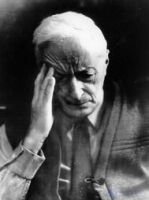 The analysis of subject and mental actions, as well as operations included in these actions, was the subject of study by P.Ya. Halperin (Halperpin P.Ya., 1998; abstract) (see Media Library). According to Halperin, "... on the part of students, the process of learning is an unbroken chain of actions: listening and understanding ... reading and writing, counting, folding and subtracting, producing grammatical, mathematical, historical analysis, etc. - all are different actions: mental, perceptual, speech, physical.These actions constitute the direct subject of study and a significant part of the subjects; the other part of them consists of ideas and concepts, which also need to be understood, understood, applied, that is, also obtained by using or include them in different actions, without which they cannot ... be presented ... The formation of actions and concepts with desired, given properties is the central psychological problem of learning "(Halperin P.Ya., 1985). Created by P.Ya. Galperin's general psychological concept of a planned gradual formation of mental actions and concepts has been confirmed and has found effective application in the practice of school education, as well as other forms of education. In general psychological terms, it is based on a new methodology of psychological research, a radical restructuring of traditional ideas about the psyche and about the subject and method of psychology.
The analysis of subject and mental actions, as well as operations included in these actions, was the subject of study by P.Ya. Halperin (Halperpin P.Ya., 1998; abstract) (see Media Library). According to Halperin, "... on the part of students, the process of learning is an unbroken chain of actions: listening and understanding ... reading and writing, counting, folding and subtracting, producing grammatical, mathematical, historical analysis, etc. - all are different actions: mental, perceptual, speech, physical.These actions constitute the direct subject of study and a significant part of the subjects; the other part of them consists of ideas and concepts, which also need to be understood, understood, applied, that is, also obtained by using or include them in different actions, without which they cannot ... be presented ... The formation of actions and concepts with desired, given properties is the central psychological problem of learning "(Halperin P.Ya., 1985). Created by P.Ya. Galperin's general psychological concept of a planned gradual formation of mental actions and concepts has been confirmed and has found effective application in the practice of school education, as well as other forms of education. In general psychological terms, it is based on a new methodology of psychological research, a radical restructuring of traditional ideas about the psyche and about the subject and method of psychology.
(http://www.psy.msu.ru/about/kaf/pedo.html; see the Department of Pedagogy and Educational Psychology, Faculty of Psychology, Moscow State University).
The transition of the external activity inward is called interiorization . According to the generally accepted point of view, this term is understood as a transition, as a result of which external in its form processes with external, real objects are transformed into processes proceeding mentally, in terms of consciousness; at the same time, they undergo a specific transformation - they are generalized, verbalized, reduced, and, most importantly, become capable of further development, which goes beyond the boundaries of the possibilities of external activity (see Khrest. 7.4).
The action, before becoming mental, generalized, abbreviated and mastered, passes through transitional states. The main of them constitute the stages of mastering the action, each of which is characterized by a set of changes in the basic properties (parameters) of the action. Open them in more detail.
The stage of drawing up the scheme of the approximate basis of the action. At this stage, students receive the necessary explanations about the purpose of the action, its object, the system of landmarks. Here, the content of the indicative basis of the action is revealed to the students. They are shown how and in what order all three types of operations involved in the action are performed: indicative, executive and control. This is not an action, but only an acquaintance with it and the conditions for its successful implementation, providing an understanding of the logic of this action, the possibility of its implementation.
It is necessary to emphasize the difference between understanding how to do it and the opportunity to do it, because in the practice of teaching it is often considered that if the student understood, it means he learned and the goal is achieved.
In fact, the assimilation of an action occurs only through the fulfillment of this action by the student himself, and not by merely observing the actions of other people. That is why in the theory of the phased formation of mental actions after the first stage, four more are distinguished, where the digestible action is performed by the student himself.
The stage of action formation in the material (or materialized) form . Students perform an action in an external, material (or materialized) form with the deployment of all its operations.
In this form, committed and approximate, and executive, and control of the action. To summarize the action in the training program includes tasks that reflect all typical cases of application of this action. At the same time, at this stage there should not be a large number of similar tasks, since at this stage the action should neither be reduced nor be automated. The material form of action from the very beginning is combined with speech: students formulate in speech everything that they do in practice.
The stage of formation of the action as external speech . At this stage, where all elements of the action are presented in the form of external speech, the action undergoes a further generalization, but remains still non-automated and unabridged.
The stage of formation of the action in the external speech to himself. This stage differs from the previous ones in that the action is performed silently and without prescription - as speaking to oneself.
The stage of formation of action in the inner speech . At this stage, the action very quickly acquires an automatic flow, it becomes inaccessible to self-observation (Talyzina NF, 1998, abstract).
The number of independent characteristics (parameters) of the action include: form, generalization, deployment and development (automation, speed, etc.) (Fig. 9).
The action form describes the level of assignment of an action by a subject, a measure of the internalization of an action. There are four main forms of action: material (materialized), perceptual, external speech and mental. Action in the process of its formation undergoes several different forms (Fig. 10).
Material action is the real transformation of an object in order to establish its properties. The materialized action is carried out using symbolic-symbolic means: diagrams, diagrams, drawings, etc. The materialized form of the action is an independent object of assimilation.
Perceptual action is an ideal transformation of real or sign-symbolic objects in terms of perception.
Speech action can be carried out as loud speech or external speech to oneself, which differ in their function: communicating to something else or to oneself.
Mental action is an action on the internal plane that is carried out without any support from any external means.
The criterion for assigning an action to one form or another is both the executive and approximate parts of the action. For example, in children, the action of tracking a line when reading, perceptual in its executive part, at the beginning of its formation is material in nature (a ruler is used for tracking). As the external supports are mastered, the action becomes removed and the action becomes ideal (mental) (Salmina N.G., 1981. P. 7-10).
The generalization of the action characterizes the measure of the selection of the essential properties of the object from the other, non-essential ones for performing the action. Studies have shown that generalization is not just based on the allocation of the general in the subjects - it is a necessary, but still insufficient condition. A generalization is always only for those properties of objects that are part of the indicative basis for actions aimed at analyzing these objects. This means that the management of the generalization of cognitive actions and the knowledge contained in them should go through the construction of the activities of the students by controlling the content of the indicative basis of the corresponding actions, and not only by ensuring common properties in the presented objects. Cases where the generalization is based on common, but non-essential features are explained as follows.
When schooling a student, at best, the composition of the signs on which to orient (through definition) is set, but not always provided orientation on them in the process of activity. Therefore, these signs are not always included in the guideline. The students themselves design an indicative basis, including in it, first of all, those characteristics of the subject that lie on the surface. As a result, the generalization is not based on the signs of the definition, but on the random, irrelevant. On the contrary, as soon as the system of necessary and sufficient features is introduced into the orienting basis of the action and systematic orientation is provided to them and only to them when all the proposed tasks are completed, the generalization follows this system of properties (Talyzina NF 1975. P. 77-78 ).
The expansiveness of an action indicates whether all operations that were originally part of an action are performed by a person. As the action is formed, the composition of the operations performed decreases, the action becomes minimized. There is a contraction of mental action. At a certain stage in the development of mental activity, part of knowledge and mental operations takes on a special form of existence: they are “meant”, are taken into account in the process of thinking, but are not actualized, do not become an object of awareness.
The mastery of the action includes such characteristics as ease of execution, degree of automation and speed of execution. At the beginning of execution, the action goes with the awareness of each operation, slowly, but gradually, the action is automated and its pace increases.
The uniqueness of the process of reducing the operational composition of actions formed means that the training program must ensure that the action is mastered in an expanded form. Reduction of an action is a genetically later condition, and, more importantly, in an abbreviated form, the action fully functions only when a person has the opportunity to restore it in expanded form (Ibid. P. 80-83).
In addition to these basic characteristics, the action has a number of secondary properties: rationality, consciousness, abstractness, durability (ibid. P. 57-61).
Preserving in the mind of the student the objective logic of the abbreviated action, the possibility of reproducing the dropped out elements is the consciousness of the action. Understanding of coagulation, not as a process of irreversible loss of elements of mental activity, but as a process of their transition into a special form of existence, allows us to explain the inefficiency of forming actions at once in a collapsed form. In this case, the logic of action is not disclosed, not realized by the subject and does not exist for him either in terms of what is actually realized or in terms of what is actually unconscious (Ilyasov II, 1986; abstract).
When performing the indicative part of the action, the subject relies on the indicative basis of the action (OOD).
The approximate basis of the action may contain reference points in a specific or generalized form, in full or incomplete composition, it can be obtained in ready-made form from another person (teacher) or independently found by a doer. Self-reliance may also be different, the student may discover benchmarks during blind trial and error or based on a particular method; the latter also either opens itself to the students or is obtained in finished form from the teacher (Fig. 12).
Varying an OOD according to these three characteristics determines its different types. Experimentally, three main types of OOD were discovered, which received conditional names - the first, second and third. Somewhat later, the fourth type of OOD was also described.
The first type is characterized by an incomplete set of landmarks in the OOD, they are specific, i.e. they are suitable only for analyzing situations of any one type and are independently discovered by the agent on the basis of trial and error.
The second type contains the entire set of landmarks necessary for the proper and reasonable execution of the action. In this case, the subject receives this aggregate in finished form.
The third type of OOD is also characterized by the completeness of the composition of landmarks, but these landmarks are not particular, but general, suitable for analyzing a certain class of phenomena. The peculiarity of this type is that the figure receives a generalized orientation system in finished form, but to analyze a specific phenomenon of this class, he independently composes a private Ltd., using the generalized Ltd. and the method of deriving particular landmarks from the general ones that were given to him.
The fourth type of OOD presupposes the existence of a complete system of general guidelines, obtained by a figure in finished form.
The types of OOD described here were first identified during experimental training. Later N.F. Talyzin theoretically obtained a complete system of types of OOD based on a combination of the above three qualities, each of which has two states - the presence or absence (23 = 8). A fifth type Ltd. was characterized as generalized, incomplete, and obtained in finished form; OOD of the sixth type - as generalized, incomplete, but compiled by the student himself; OOD of the seventh type - as a specific, complete, compiled by the students themselves; OOD of the eighth type - as a concrete, incomplete, obtained in finished form.
The latter type of OOD is actually implemented in traditional training.
V.V. Davydov conducted a comparative analysis of the second and third types of OOD. He showed that the second type provides orientation at the level of the phenomenon, without penetrating into its essence. At the same time, empirical, rather than theoretical, thinking is formed. Theoretical thinking can only be formed using a third type DTE. In this case, the cognition of the essence of phenomena, finding their universal basis, or the source from which all diversity of phenomena arises, and understanding how this basis causes the emergence and interconnection of phenomena in a given field is provided (Davydov VV, 1972). True, with an OOD of the third type, the student does not independently find this universal basis, but receives it in finished form from the teacher.
The problem of OOD types, however, also cannot be considered completely solved. Further studies can go in the direction of both a more detailed analysis of the types already described, and the identification of additional, new properties of the Ltd., consideration of which will lead to an increase in the number of its types: 24 = 16, 25 = 32, etc.
The first type of teaching - it was called “by trial and error” - is characterized by an incomplete orienting basis for action. The assimilation of knowledge and skills when using an OOD of the first type is very slow, with a large number of errors. An action that is performed on the basis of a skill formed in this way turns out to be very sensitive to the most minor changes in the conditions for its implementation. The expediency of such an action is relative, since it also contains useless operations. It is not reasonable, although within certain limits it can be performed correctly. Transfer to new tasks is negligible. In fact, this type of teaching is uncharacteristic for the assimilation of social experience, since it relies on its own discovery by the actor of the necessary guidelines.
The student is given a sample of the action to which he orients as the final result. At the same time, all objectively necessary conditions of action remain hidden and are clarified by the students themselves, what happens by chance and, as a rule, is incomplete. Results vary widely in performance. This type leads to the accumulation of knowledge and skills, but does not develop thinking or ability. Training is based on already achieved opportunities. The first type corresponds to the traditional learning process, the basis of which is "... a sensualistic, passive-association understanding of the process of mastering school knowledge" (VV Davydov, 1972. P. 15). He was later named V.V. Davydov "associanistic-reflex theory of learning". V.V. Repkin calls it an illustrative method of teaching.
The second type is distinguished by the construction of an action on a full indicative basis, offered in finished form and for individual objects. Обучение идет без проб и ошибок, планомерное воспитание желаемых свойств позволяет достичь намеченных результатов без существенного разброса успеваемости.
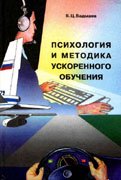 При втором типе ООД усвоение идет быстро, точнее, при наличии незначительного количества случайных ошибок. Время, затрачиваемое на усвоение, невелико. Поскольку учащийся учитывает при выполнении действия все объективно необходимые условия, то действие не просто целесообразно (правильно), но и разумно. При этом желаемый результат получается стабильно: если нарушаются привычные, но несущественные условия, то действие остается успешным. Перенос на новые задания осуществляется по принципу тождественных элементов. Учение с использованием ООД второго типа является типичным случаем усвоения социального опыта - усвоения в специально организованных условиях.
При втором типе ООД усвоение идет быстро, точнее, при наличии незначительного количества случайных ошибок. Время, затрачиваемое на усвоение, невелико. Поскольку учащийся учитывает при выполнении действия все объективно необходимые условия, то действие не просто целесообразно (правильно), но и разумно. При этом желаемый результат получается стабильно: если нарушаются привычные, но несущественные условия, то действие остается успешным. Перенос на новые задания осуществляется по принципу тождественных элементов. Учение с использованием ООД второго типа является типичным случаем усвоения социального опыта - усвоения в специально организованных условиях.
В сравнении с традиционным второй тип учения представляет собой кардинальное его усовершенствование. Однако он имеет существенные ограничения, если выйти за рамки его практических оценок. Нацеленный на усвоение готового знания, он не воспитывает у учащихся теоретического познавательного интереса, обучение сводится к овладению путями подведения под понятия (Бадмаев Б.Ц., 1998; аннотация).
Принципиально новые возможности открывает третий тип учения. При третьем типе ООД усвоение также происходит без существенных ошибок. Разумность действия, умение выполнять которое формируется с использованием такой ООД, еще выше, поскольку учащийся не только учитывает условия, необходимые для достижения желаемого результата, но и хорошо понимает их содержание, их отношение к будущему продукту. Это является основной причиной повышения устойчивости действия. Перенос на новые задания является полным (в границах намеченной области). Процесс усвоения идет легко, хотя на первых порах учащемуся может понадобиться определенное время на овладение новым методом работы, - последнее
продолжение следует...
Часть 1 7. DEVELOPMENT OF KNOWLEDGE, SMART AND SKILLS
Часть 2 7.4. Общеучебные умения и навыки - 7. DEVELOPMENT OF KNOWLEDGE,
Comments
To leave a comment
Pedagogical psychology
Terms: Pedagogical psychology